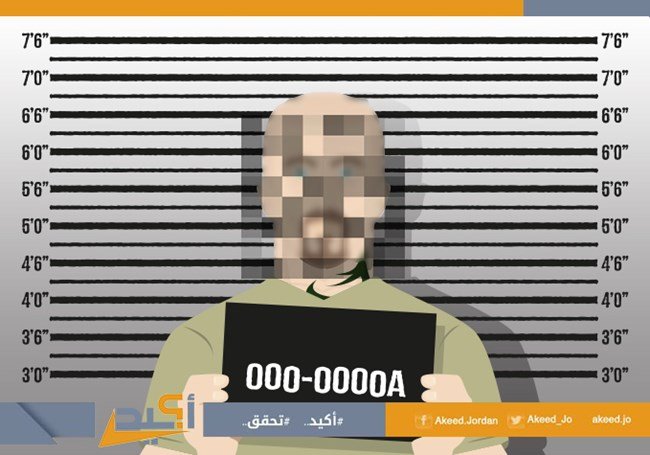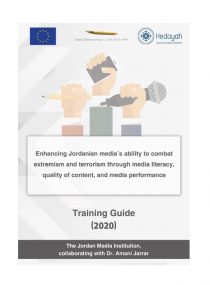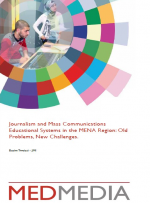Image:

14 Feb 2018
14 Feb. 2018 <br />
<br />
Amman, AKEED - The Jordanian Media Credibility Monitor (AKEED) has developed a set of guidelines that media organizations and journalists may follow to handle the publication of photos and names of criminals and victims. In a press release issued today, AKEED said that the guidelines were based on a number of international journalistic ethical standards in this field in light of the absence of explicit legislation that addresses the publishing of the photos of criminals and victims and the reliance mainly on codes based on self-regulation of the profession of journalism.<br />
<br />
The Public Security Directorate has recently published explicit names and photos of the suspects involved in recent armed robberies of banks and shops and issued a statement specifying the cases in which the photos of the suspects would be published in the future.<br />
<br />
The AKEED press release pointed out that the publishing of photos and explicit names of the suspects in robbery cases has triggered a debate. Some people viewed this as a deterrent to criminals and a means of warning the public, while others considered it unjustified slander of the suspects.<br />
<br />
Following are the guidelines:<br />
<strong>First: Names and Photos of Criminals</strong>
<ul>
<li>A legal distinction should be made between the suspect (the person who is arrested), the accused (the person appearing in court), and the convict (a person against whom a final court ruling of conviction has been issued).</li>
<li>Not publishing the names or photos of children and juveniles who are in conflict with the law at all.</li>
<li>An accused person is presumed innocent until proven guilty. Therefore, the names and photos of the suspects or accused persons in crimes and cases may not be published until a final ruling has been issued, while considering the social value that the publishing will achieve, even if a final ruling of conviction is issued.</li>
<li>Refraining from publishing anything that is being handled by the investigating authorities or court in criminal or civil cases in a manner that seeks to influence the investigation or the trial.</li>
<li>Not considering the publishing of the names and photos of suspects by the security agencies to be a justification for publishing such names and photos, and subjecting them to the standard of social value prior to newsworthiness.</li>
<li>Not publishing the full name of the suspect, accused, or convict and subjecting it to the standard of the social value prior to newsworthiness.</li>
<li>The photos of persons convicted in cases of repeated sexual assault on children may be published since this is the best way to warn families and children of them.</li>
<li>The photos of suspects who commit serious crimes that threaten the security of the public, in the case of being on the run, may be published in order to warn and seek help in arresting them.</li>
<li>Not publishing the photos or names of suspects, accused persons, or convicts in cases related to personal status, privacy of the public, and family cases, such as divorce, adultery, and alimony.</li>
<li>In the case of publishing the photo of a convict or suspect who is on the run, the photo must be neutral and without any effects that could encourage violence and crime and that show the person in a heroic manner. Likewise, it is not permissible to publish a scandalous photo of the suspect that could influence due process.</li>
<li>The explicit names and photos of accused persons who receive a final ruling of acquittal may be published, while refraining from publishing them throughout the trial.</li>
<li>Avoiding publishing the names and photos of persons convicted in minor offenses that do not pose a threat to society and who do not have prior convictions so as to help those people correct their course and not slander them in society.</li>
<li>Media outlets may not seek deliberately to ridicule a convicted person through pictures or cartoons or by criticizing a physical disability or criticizing his ethnicity, religion, sex, or nationality.</li>
<li>It is permissible to publish the first name and photo of a suspect in repeated and serious offenses (serial killer) or whose case has stirred up public opinion prior to his arrest. This is considered some kind of documentation of major crimes.</li>
<li>If there is a connection between a public post and a crime committed by one of the officials or elected persons, his photo may be published over several stages (suspect, accused, and convict).</li>
<li>Not publishing the photos or names of the family members of the suspect, accused, or convict unless one of them explicitly allows this provided that publishing them must be newsworthy and while ensuring that none of them would be subject to reprisals by the families of victims or members of the community.</li>
<li>Ensuring the right of convicts who have served their sentences and returned to society to be forgotten and not retrieving their names or photos from the archive and republishing them.</li>
</ul>
<br />
<strong>Second: Names and Photos of Victims </strong>
<ul>
<li>The fundamental rule in deciding whether to publish a photo or not is assessing the impact of publishing on the right of the public to know and the benefit that publishing or not publishing a photo may achieve. </li>
<li>Not publishing the photos and names of victims of sexual or domestic assaults, particularly children, in view of the sensitivity of these cases and their impact on victims in the future.</li>
<li>Not publishing the photos that are taken of the victims of murder at the crime scene in a manner that violates the sanctity of the dead and publishing only a photo that shows the crime scene without showing the features of the dead person.</li>
<li>Archival pictures of a murder victim may be published provided that the victim appears in good health.</li>
<li>Not publishing the photos of kidnapped persons except with the approval of the security authorities in order not to influence their life.</li>
<li>Not publishing the photos of missing persons except at the request of the security authorities or the parents of the missing person to ensure not affecting the search and investigations.</li>
<li>Not publishing the explicit names and photos of persons who commit suicide. Most foreign media outlets do not cover such incidents because they encourage others to commit suicide, unless the incident involves a certain place, specific ritual, or a public figure or celebrity.</li>
<li>Not publishing the photos of the victims of murders that are carried out by terrorists in a gruesome manner and publishing only archival pictures of the victims while in good health to ensure respect for the feelings of their families.</li>
<li>It is permissible to publish the photos and names of the victims of genocide, ethnic cleansing, and crimes committed based on religion, belief, nationality, or sex while not publishing gruesome pictures or others that violate the sanctity of the dead.</li>
<li>The agreement of any victim to publish his/her photo does not necessarily mean that the journalist cannot balance the victim's decision against the possibility of the decision reflecting negatively on the victim himself/herself, especially in conservative communities, such as facing reprisals.</li>
<li>Not publishing live photos of the victims of kidnapping and hostages in robberies and terrorist acts from the crime scene, out of fear that their identities might be revealed.</li>
</ul>



